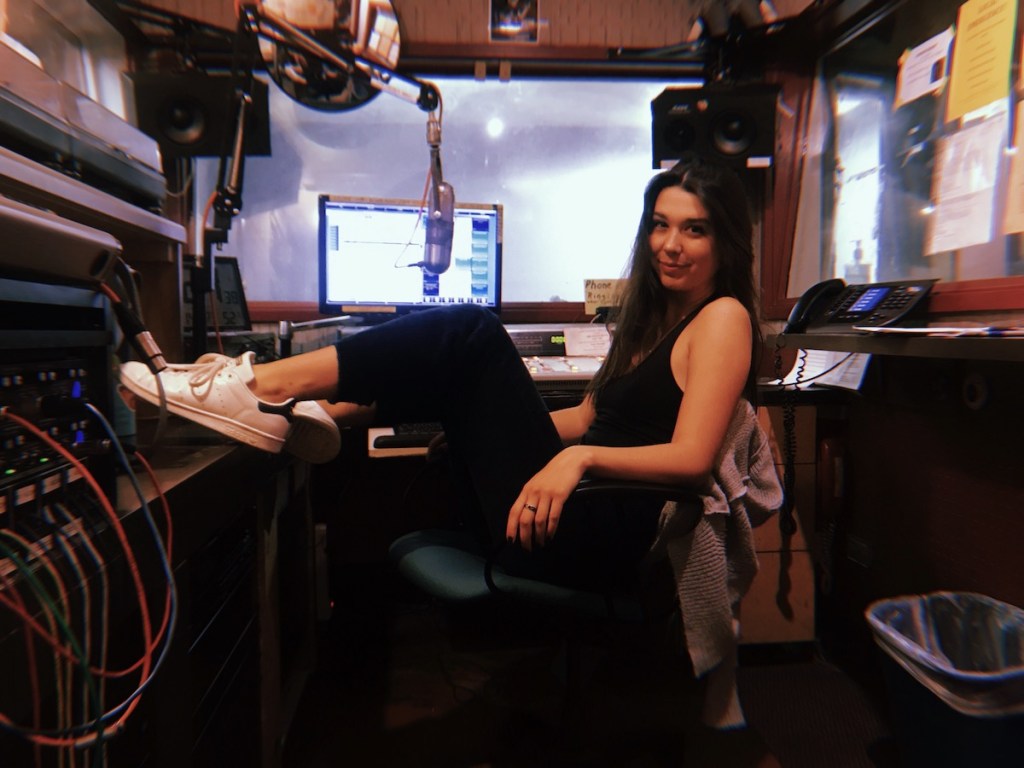Molly McAnany wears many hats as the creator of our podcast, The Indy. Not only is she the host and editor — but she’s parlayed her background as a classically trained pianist into crafting theme music for the audio streamer. We asked her some questions about it below.
Did you play all the instruments on the opening theme?
I play a few instruments. I play piano, guitar – I’m gonna include harmonica in there, because that’s fun. I’ve been working on my bass skills. And I’m actually learning right now to play the bagpipes. Because I’m very Irish. So my family’s like, someone needs to learn it.
But for the actual episode, I really only played piano because I don’t play horns. So I have a MIDI keyboard because, funny enough, I actually started off as a music composition major when I applied to colleges. So I had like a reel and a bunch of score soundtracks and things like that.
But I have a MIDI keyboard that just hooks up to my software, which is Logic. And I am a classically trained pianist. So I do a lot of stuff on the piano, like horns, strings, synth – all of that stuff just happened to be on the piano.
I was just sitting at my desk and I was like, “You know what, this needs a theme.” And I popped my MIDI out, and I just wrote it. … It’s probably a six multitrack instrumental, like it is the simplest thing ever. But sometimes simple is better. I took a lot of inspiration from Serial, which is literally one note.
Are there any other themes across podcasts that stand out to you?
So I took a lot of inspiration from the kind of newsy themes that you hear on CBS [or] ABC. I took that, but then I kind of combined it with Pushkin theme songs. I love NPR’s Invisibilia soundtracks. I love how they use music to kind of push the story forward.
And that’s what I kind of have been working on doing with the podcast. Music should be something that brings the listener back in. It’s like, you should have something different happen every two to three minutes in the show so that people don’t just wander off in their mind and then go somewhere else. Having that music to be like, “Oh, something’s speeding up here.” Like in Serial when they’re about to announce like who the murderer is. You feel that suspense through the music.
Any audio format has to have some sort of music element or sound element, because it’s only one sense. And it’s really easy to disengage that sense after a long period of time.
Sign up for Indy Today to receive fresh news from Independent.com, in your inbox, every morning.
Do you use that music sensibility to gauge the rhythm of your speakers?
Yeah, so I have four different sounds that I’ve written. One of them is the theme song. And then I have three melodies. So there’s this one really quiet piano one that’s for more serious, sadder topics. It’s very calm, and like, it could be used for even a book talk or something like that. The one that I use most often is the more newsy one. It’s kind of like the same thing they did for Serial. It’s like the “dun, dun, dun, dun.” And there’s a bassline, and really quick drums.
But yeah, I make it match whatever the theme the speaker’s talking about.
I have a very limited supply of them. So there’s basically four groups that they fit into right now. But hopefully, I’ll get to writing more, and it’ll make it more dynamic.
Will you ever drop a full version of the themes?
I mean, honestly, that would be awesome. I probably should. I’ve actually had a couple ideas.
I would love to drop a full version of the Indy theme. I don’t even know where I would go with it. Because what I love about news themes is that they’re so short. And that’s it. That’s all you get. But I think that there’s other themes within the show that I could build upon for more episodes.
Right now I kind of have a Q&A format because it’s just me editing, hosting, doing the whole thing. So it’s an easier format for me to put together. But I think that I’m ambitious enough to kind of go that way. And maybe we’ll get some more theme music for that. We’ll have to expand it a bit more.
I listened to the I Madonnari episode, and you talked about partaking in Pianos on State, and how interconnected the art scene is in Santa Barbara.
That’s the thing, with this day and age, there’s so much connectivity. I mean, I’m literally doing a podcast on connectedness with surfers who talk about philosophy. And it made me really think [about] how in this day and age, if you’re a creative, how much accessibility you have to [become] – I don’t like to say Jack of all trades, because then, you know, the ending is master of none. I always like to say a utility player.
If you can come into any space and be a utility player, be someone who can do audio, who can write the music, who can script / edit. … I think that’s what makes the creative mind happiest is when you’re able to spread yourself like that and be like, “I have complete control over what my next project is.”
This interview has been edited for clarity. Listen to The Indy podcast here.
This podcast was underwritten in part by the Mickey Flacks Journalism Fund for Social Justice, a proud and innovative supporter of local news. To make a contribution, go to sbcan.org/journalism_fund. To sponsor The Indy, contact advertising@independent.com.

